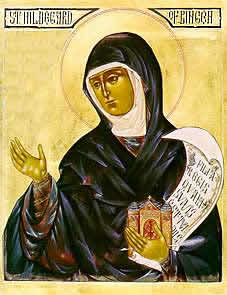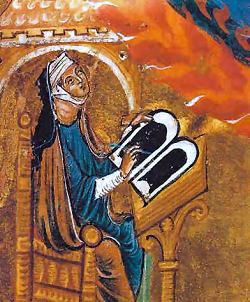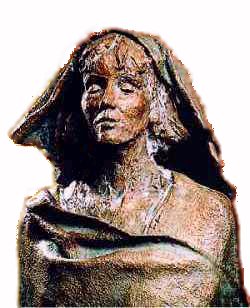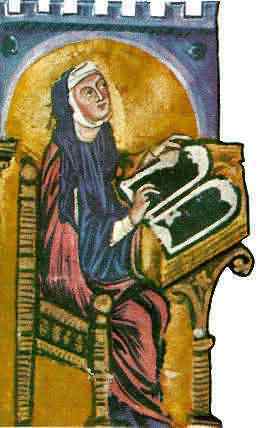| Hildegard von Bingen:
The Biography of a Feminist Nun The Feminist eZine - Religion
Hildegard von Bingen - Circa 1098-1179Biography researched by Charles Moffat - 2002.
She was a poet, author, philosopher, theologian, singer, musician, composer, playwright, artist, architect, biographer, doctor, botanist, herbalist, visionary, preacher, seer, prophet and a Saint. Hildegard is credited with inventing opera. She endorsed beer drinking for the nuns because she believed the drinking water was not safe and it gave them a rosy complexion. She invented her own coded language. Early Life: Born in the Rhineland. Her parents gave her to the church when she was 8 and she was sent to live with a “holy hermit”/nun named Jutta of Sponheim, who lived beside a monastery (St. Disibod). The church became a popular place for women spiritualists and Jutta became their mother superior. Hildegard took vows during her teens and when Jutta died when Hildegard was 38, she replaced Jutta as the mother superior. During her youth she experienced visions but kept them secret.
Rise to Power: After becoming mother superior, she had a vision that she should spread the knowledge of her visions instead of keeping them secret. She began recording her visions with the aid of a monk. Her writing and letters became popular and the abbey overflowed with the arrival of novice nuns. After a power struggle in 1150 with the abbot who wanted her to stay at St. Disibod, she moved to Rupertsberg (near Bingen) and brought 50 nuns with her, to found a new abbey. The abbey became so popular she had to found a second abbey in Eibingen, less than 8 miles away. She was the architect for both abbeys, which included running water and large workshops for the nuns to develop their artistic and intellectual skills. She promoted reading, theology, warm baths, regular exercise, singing, and musical instruments. She did not trust the local water, and thus promoted beer drinking. Her abilities as a doctor made her respected as a miracle woman. According to legends, the crowds that gathered for miracle healing were so bad that her fellow nuns tried to convince the bishop to order her to stop performing miracles. She wrote two books on medicine, Scivias and Causae et Curae (Cause and Cure), as well as numerous other writings about herbalism, botany, geology, biographies of Saints. She wrote plays, poetry and wrote/directed the first operas. She went on four preaching tours, each lasting several years. Preaching for women was illegal, but she did it anyway. She refused to allow the church to treat women as subservient to men, she rejected negative stereotypes of evil seductresses, and taught that woman was indeed created in the image and likeness of god. She taught the following: Her controversial ideas resulted in her being reprimanded by other clergy, but because the Pope respected her as a seer, she went unpunished.
Later Years: At the age of 80, she defied the church by burying a revolutionary at her abbey. Fellow clerics ordered her to exhume the body. She protested that the man had had his sins absolved. The clerics authorized local authorities to exhume the body, but she formally blessed all of the graves and then removed the tombstones so that they could not tell which grave was his. The clerics placed a ban on mass and music within her abbey, but the ban was later lifted.
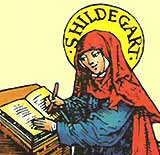 Sainthood: The process of becoming a Saint began after her death, but it was never completed for unknown reasons. Her cult of followers remained in the Rhineland, and in 1940 the Vatican finally acknowledged her sanctity and made her a saint. Her feast day is September 17th. 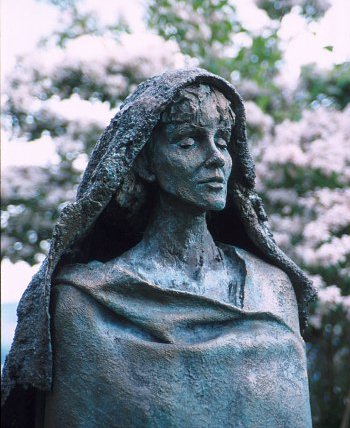
Popularity: The Cult of Hildegard, nuns who revered her teachings continue to live in the Rhineland. New Age spiritualist, Matthew Fox, established her in his writings as a strong feminine figure. Musicologists credit her with the invention of opera and a Gregorian composer. The New Grove Dictionary of Music and Musicians gives her 6 pages. Violinist Jocelyn Montgomery has a CD out on Hildegard’s music. There are several statues of her in the Rhineland and numerous paintings. Historians of science, religion and feminism have written numerous books on her within the last 10 years. The Vatican is currently in the process of recognizing her as a Doctor of the Church, of which there has only been 5 previously. As Bertolt Brecht (dramatist) would say, Popularity is dependent upon having an audience. Hildegard has a very big audience with a variety of different tastes.
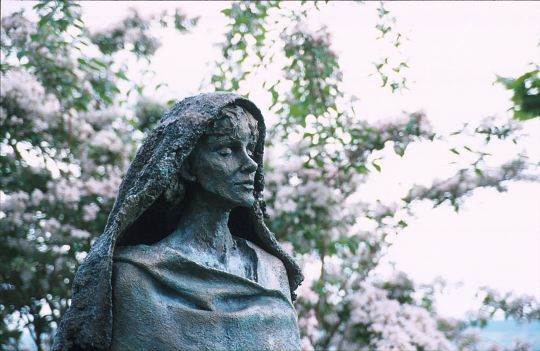 |
|
